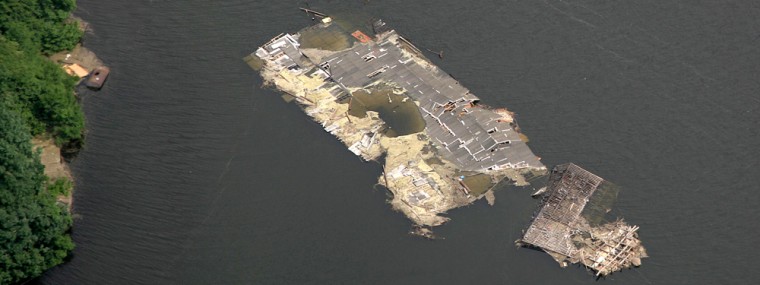Water began flowing into a spillway Saturday from a swollen lake formed by a landslide in China's devastating earthquake, easing the immediate threat of a flood that had led to the evacuation of more than 250,000 people.
Engineers were monitoring bridges and river banks downstream to see if they would hold under the rush of water, and work crews were trying to dig a secondary channel to improve the flow, China Central Television and the Xinhua News Agency reported.
The water that had been building behind the landslide for nearly four weeks appeared to stabilize, the State Council, China's Cabinet, said in a report posted on its Web site.
The draining of the 286 million cubic yards of pent-up water was earlier delayed while troops rushed to expand the channel, worried the dam wall of rock and mud could give way and unleash a dangerous surge, Xinhua reported.
"Emergency work is still proceeding urgently, but in the foreseeable future there's no risk of the dam collapsing," Xinhua quoted Chengdu Military Region Deputy Commander Fan Xiaoguang as saying.
Almost 70,000 dead
Worries about the collapse of Tangjiashan lake have driven authorities to mount a hurried effort to build the diversion channel to carry water over the landslide that blocked the Tongkou River. Workers deepened the channel Friday, and after steady rain, water flowed Saturday morning, state media reported.
The potential collapse of the lake threatened to flood an area that is home to more than 1 million and compound the misery in a disaster zone still reeling from the May 12 magnitude-7.9 quake that has killed nearly 70,000 people.
"I can't even cry, even if I want to. First it was the earthquake, now it's floods," said Yu Taichun, a doctor who was keeping watch over a small medical center in a tent city of about 2,500 people on the forested slopes of the Taohua, or "Peach Blossom," Mountain.
Yu said he has moved five times since the quake, arriving about two weeks ago at the latest camp overlooking the town of Qinglian, about 20 miles downstream from Tanjiashan lake.
Nerves were frayed among the refugees, who had little to do except wait for updates on the lake — the largest of more than 30 that have formed behind landslides.
Heatstroke was becoming a problem in the camp, where temperatures in the tents would often top 100 degrees, Yu said. Trucks delivered water several times a day, but there were no shower facilities and toilets were backed up.
Overreaction?
In the nearby city of Mianyang, some questioned whether the government had overreacted to the lake's threat after residents were evacuated from more permanent camps more than a week ago without any clear idea of when the lake would drain — or burst.
Chinese Premier Wen Jiabao was impatient to defuse the quake lake threat and return attention to the millions of people displaced by the earthquake, many of whom are living in crowded tent camps.
"The longer the delay, the greater the pressure created by the quake lakes, with safety threats multiplying and new hazards more likely to arise," Wen said near Mianyang, a threatened downstream city, on Friday, according to state television news.
'What can you do?'
On Friday, the area was deluged with rain. Residents cooked their dinners over open fires while holding umbrellas. Others, loaded down with black discs of coal for fuel, struggled to walk on the muddy ground. Many scrambled to close off their makeshift homes to the downpour.
The evacuees were resigned. "What can you do?" was a common lament.
Technicians were keeping a wary eye out for both increased rainfall and further landslides that could set off a flood surge in the lake, located in the mountains north of where the earthquake was centered.
Along with communities downstream, the Tangjiashan lake also threatens a state-owned oil pipeline some 35 miles away, the company said. General Manager Jiang Jiemin flew to the scene to oversee measures to protect the pipeline, billed as the longest and widest in China.
Donations reach $6.3 billion
Amid scattered complaints of misuse of quake aid, the government's National Audit Office announced it would "investigate and deal with any attempt to hide, intercept or misappropriate" donated funds and materials, Xinhua said.
Domestic and foreign donations had reached $6.3 billion as of Thursday, Xinhua said. It said the audit office's report would be issued around June 20.
The quake centered in Sichuan province killed 69,127 people, with 17,918 still missing, according to the latest government figures.
Reverse sterilization operations
The provincial government has estimated about 7,000 of the victims were children with no siblings. The National Population and Family Planning Commission will send a medical team to the quake zone to perform reverse sterilization operations on couples that want to have another child, Xinhua reported.
China's family planning policies restrict most couples to one child, although rules allow for another baby if their child is killed, severely injured or disabled.
Authorities said they had recorded 4,700 unclaimed children whose parents presumably died in the quake. But Civil Affairs Ministry official Zhang Shifeng said the final number of orphans was expected to be about 1,000 to 2,000, as children were gradually handed over to members of their extended families.
Zhang said parents from around China were showing huge interest in adopting quake orphans, with 10,000 families registering for adoption in one province alone. He indicated the ministry could give priority to parents who children in the quake.
